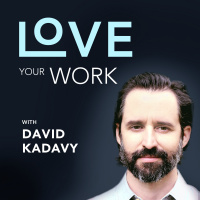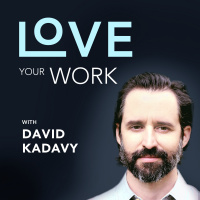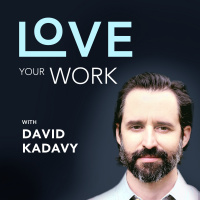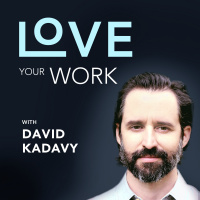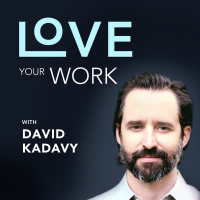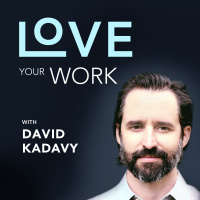Love Your Work Creative Habits | Writing | Solopreneur | Productivity | Entrepreneurship | Startup
- Autor: Vários
- Narrador: Vários
- Editora: Podcast
- Duração: 166:20:19
- Mais informações
Informações:
Sinopse
Best-selling author David Kadavy (@kadavy) interviews James Altucher, Jason Fried, Seth Godin, and other entrepreneurs and creators who have achieved success by their own definition, and built lives and businesses that are uniquely theirs.
Episódios
-
308. Why I Quit Podcasting
10/08/2023 Duração: 11minAfter nearly eight years of the Love Your Work podcast, I’m quitting. Here’s why, and What’s Next. Podcasting is a bad business This is not the immediate reason I’m quitting, but it is at the root: Podcasting is a bad business. When the indirect benefits of an activity run out, it’s hard to keep doing it if it’s not making money. I realized long ago podcasting is a bad business, but I kept going for other reasons. I’ll explain why in a bit. Though I didn’t start my podcast with dollar signs in my eyes, I did at least hope I would grow to earn money doing it. I’ve earned about $32,000 in the eight-year history of Love Your Work. More than half of that has been from Patreon supporters, many of whom support for reasons other than the podcast. During that time, I’ve spent: $1,008 on hosting $11,749 on assistance with editing and publishing $241 on equipment And some other expenses, for a total of about $13,000 In raw numbers, I’ve made a “profit” on the podcast. But, as I broke down in my latest income report,
-
307. A.I. Can't Bake
27/07/2023 Duração: 09minYou’ve probably heard that, in a blind taste test, even experts can’t tell between white and red wine. Even if this were true – and it’s not – it wouldn’t matter. I was in Rome last month, visiting some Raphael paintings to research my next book, and stopped by the Sistine Chapel. I’ve spent a good amount of time studying what Michelangelo painted on that ceiling. There are lots of high-resolution images on Wikipedia. But seeing a picture is nothing like the experience of seeing the Sistine Chapel. You’ve invested thousands of dollars and spent fifteen hours on planes. You’re jet-lagged and your feet ache from walking 20,000 steps. You’re hot. When you enter, guards order you to keep moving, so you won’t block the door. They corral you to the center, and you can finally look up. When you hear wine experts can’t tell between white and red wine, you imagine the following: Professional sommeliers are blindfolded, and directed to taste two wines. They then make an informed guess which is white, and which is red.
-
306. Summary: The Triumph of Doubt by David Michaels
13/07/2023 Duração: 17minWe trust the food we eat, the drinks we drink, and the air we breathe are safe. That in case they’re unsafe, someone is working to minimize our exposure, or at least tell us the risks. In The Triumph of Doubt, former head of OSHA David Michaels reveals how companies fight for their rights to sell harmful products, expose workers to health hazards, and pollute the environment. They do it by manufacturing so-called “science.” Most this science is built not upon proving they’re not causing harm, but by doing whatever they can to cast doubt. Here, in my own words, is a summary of The Triumph of Doubt: Dark Money and the Science of Deception. Products we use every day cause harm Chances are you’ve cooked on a pan coated with Teflon. Teflon is one of many polyfluoroalkyl substances, or PFAS. When introduced in the 1940s, they were considered safe. We now know they’re linked with high cholesterol, poor immune function, cancer, obesity, birth defects, and low fertility. PFAS, it turns out, have such a long half-life,
-
305. Hedgehogs and Foxes
29/06/2023 Duração: 12minAccording to philosopher Isaiah Berlin, people think in one of two different ways: They’re either hedgehogs, or foxes. If you think like a hedgehog, you’ll be more successful as a communicator. If you think like a fox, you’ll be more accurate. Isaiah Berlin coined the hedgehog/fox dichotomy (via Archilochus) In Isaiah Berlin’s 1953 essay, “The Hedgehog and the Fox,” he quotes the ancient Greek poet, Archilochus: The fox knows many things, but the hedgehog knows one thing. Berlin describes this as “one of the deepest differences which divide writers and thinkers, and, it may be, human beings in general.” How are “hedgehogs” and “foxes” different? According to Berlin, hedgehogs relate everything to a single central vision. Foxes pursue many ends, often unrelated or even contradictory. If you’re a hedgehog, you explain the world through a focused belief or area of expertise. Maybe you’re a chemist, and you see everything as chemical reactions. Maybe you’re highly religious, and everything is “God’s wi
-
304. Too Many Ideas, Must Pick One
15/06/2023 Duração: 12minMany creators and aspiring creators struggle not because they don’t have enough ideas, but because they have too many. Their situations, in summary, are “Too many ideas, must pick one.” Embedded in this belief are assumptions that, if challenged, can help you feel as if you have just enough ideas. In my recent AMA, I got a question I’m asked about creativity, probably more than any other: How can you pick a creative project when you have too many ideas? I’ve experienced, “too many ideas, must pick one,” many times. I still often do. I of course answered this question in the AMA, but here I’ll answer more in-depth. This is the thought process I guide myself through when I’m in the land of “too many ideas, must pick one.” There are three assumptions embedded in, “too many ideas, must pick one.” All these ideas are equally likely to succeed. I’m equally capable of succeeding at each of these ideas. I can’t work on multiple ideas at once. Let’s look at each of those. Assumption 1: “All these ideas ar
-
303. Livestream/AMA: Publishing Outside Amazon, Focusing Curiosity, and Mind Management
01/06/2023 Duração: 54minToday I have a special episode for you. If you missed last month’s AMA/Livestream, I’m delivering it right to your ears. In this AMA, I answered questions about: What’s the best self-publishing platform, and how did I publish 100-Word Writing Habit, non standard-sized, outside of Amazon? Buenos Aires versus Medellín, which is better for mind management? How to pick a creative project when you have too many ideas? What’s surprised me most in the past two years? What task management software do I use for mind management? How to focus on one project when you have multiple curiosities? How to keep from falling down a research rabbit-hole? How many half-formed ideas do I have captured somewhere? There are some parts where I refer to visuals, for the best experience, watch on YouTube. About Your Host, David Kadavy David Kadavy is author of Mind Management, Not Time Management, The Heart to Start and Design for Hackers. Through the Love Your Work podcast, his Love Mondays newsletter, and self-publishing coachin
-
302. The Four Sources of Shiny Object Syndrome
18/05/2023 Duração: 09minShiny object syndrome can be evidence of a problem, or it can be a normal part of the creative process. If you can identify the four sources of shiny object syndrome, you can tell the difference between being lost, or simply exploring. Three first three sources are problems The first three of the four sources of shiny object syndrome hold you back from finishing projects. They are: ambition, perfectionism, and distraction. Ambitious shiny object syndrome is starting projects that far outpace your abilities and resources. Perfectionistic shiny object syndrome is endlessly tweaking a project that could otherwise be called done. Distracted shiny object syndrome is juggling so many projects, you finish none. Before we get to the fourth source, a bit more about these three most dangerous sources. Ambitious shiny object syndrome You probably have a friend with ambitious shiny object syndrome. One day they proclaimed they were writing an epic fantasy novel. A few months later, they had dropped that and had a new p
-
301. 1,500 Words on Writing a 5-Word Tweet
04/05/2023 Duração: 12minWriting a tweet is a microcosm of writing a book. If you think deeply and carefully about every word in a tweet, and what the tweet as a whole communicates, you can extend those skills to all your writing. In this article, I’ll break down how to think about every word in a tweet, nearly tripling its performance. Step 1: The first-impression tweet The tweet we’ll work on came to me like most tweets, a thought that popped into my head. It was this: Ironically, strong opinions are the ones that are easily argued against. I could have just tweeted that. But I’ve made a habit of instead writing down my first-impression tweets in a scratch file, and later working on them before publishing. Here’s what my thought process looks like. As a tweet, this phrase is a little wordy, and weak. It starts somewhat nonsensically with an adverb: “Ironically.” What action is being performed ironically? Step 2: Improving word economy There are also some extra words that could be cut out. Do we have to refer to “strong opinions”
-
[Bonus Patreon Preview]: Coffee w/ Kadavy #4
27/04/2023 Duração: 41minHere's a bonus preview of a new podcast I've brewed just for Patreon supporters. It's Coffee w/ Kadavy. In this episode, #4, I talk about: I talk with special guest ChatGPT about why we will (or won't) see another AI winter An inventory of things I believe (at least more than 50%) A cool thing that makes reading paper books way more comfortable! A (controversial?) history book about an amazing clash of civilizations For more episodes of Coffee w/ Kadavy, join the Patreon! There are three more episodes waiting for you, and a sneak audiobook preview of a chapter from my next book.
-
300. The Mechanics of Media
20/04/2023 Duração: 19minEvery message is shaped by the mechanics of media. Whether it’s a tweet, a TikTok video, a news article, or a movie, the characteristics of the medium determine how it’s made, how it’s consumed, and whether it spreads. If you understand the mechanics of media, you can more effectively communicate in a wide variety of mediums, and protect yourself from being manipulated by media. The message is the mechanics of media As media theorist Marshall McLuhan said, “The medium is the message.” In Understanding Media, he wrote: The medium is the message. This is merely to say that the personal and social consequences of any medium...results from the new scale that is introduced into our affairs.... In other words, it’s not the content of the medium we should be worried about, but the way the characteristics of that medium determine its content – the mechanics of media. The five characteristics of media I propose that there are five characteristics present in any medium, which determine these mechanics. These
-
[NOTE] Submit your questions for the upcoming AMA/Livestream! (kdv.co/ama)
13/04/2023 Duração: 01minSubmit your questions and mark your calendars for my upcoming AMA/Livestream.
-
299. Why Make Predictions? (and How)
06/04/2023 Duração: 15minMaking, recording, and evaluating predictions is a simple way to improve your thinking and decision-making. But the way to properly make and record predictions isn’t obvious. In this article, I’ll share some predictions I’ve made, what I’ve learned, and how you can improve your thinking by making predictions. Making predictions has grown my business Five years ago, I had been running my business for ten years, and it wasn’t going great. Then, I started publishing monthly income reports, and along the way, making predictions. My income has nearly doubled, and I attribute much of that success to my habit of making predictions. I began by predicting how much money I’d make in a product launch, and grew to predicting how much traffic articles I had written would gain, and how many copies books I’d written would sell. I now routinely make predictions for things as seemingly mundane as whether I’ll enjoy a conference, whether I’ll still be publishing on TikTok a year from now, or whether an avocado is ripe. On
-
298. Kellogg's 6-Hour Day
23/03/2023 Duração: 15minIn the midst of the Great Depression, cereal manufacturer Kellogg’s switched to a shorter, six-hour day. This continued a trend that seemed inevitable: people would work less and less. But economic policies, management strategies, and cultural attitudes changed. The story of the rise and fall of Kellogg’s six-hour day is a microcosm of these changes, as well as of our attitudes about the roles of money, leisure, work, and women and men. In the book, Kellogg’s 6-Hour Day, historian Benjamin Kline Hunnicutt shares his findings in studying Kellogg’s shorter workday. His main sources of information were 434 interviews conducted by the Women’s Bureau of the Department of Labor, 124 interviews he himself conducted of workers, and 241 responses to a survey he had sent. What follows is a summary of the story, and Hunnicutt’s findings. Kellogg’s switched to a 6-hour day to create jobs During the Great Depression, American businesses took on a policy of “work sharing.” The idea was that fewer would be unemployed i
-
297. Desire Paths
09/03/2023 Duração: 09minDesire paths are trails left on the ground, by anything that frequently travels along a route. There are subcultures fascinated by desire paths as symbols of collective wisdom, disregard for authority, or mere evidence of existence. Desire paths are also celebrated as a design technique. Desire paths in their pure form are about what you can see, but the characteristics of desire paths – which you can’t always see – can help you optimize your life and gain clarity in your creative projects. Desire path examples Desire paths are also known by a number of other names: cattle trails, cow paths, elephant paths, just to name a few. In forests or grassy meadows, it seems pretentious to call them desire paths – they’re just paths. Desire paths that question authority Desire paths are most interesting when they show up in places where a man-made path has already been put in place. A sidewalk turns a corner at a ninety-degree angle, but as people cut the corner, a desire path develops at forty-five degrees. An o
-
296. Beyond Vulnerability
23/02/2023 Duração: 12minThe term, “vulnerability” has spread into realms where it’s not an accurate description of what’s going on. The case for being vulnerable often doesn’t make sense. In the creative realm – and possibly in others – we should pursue something beyond vulnerability. When I wrote about vulnerability to my Love Mondays newsletter, saying some of what I’m about to say, I got a lot of pushback. In the current – and what I believe to be incorrect – parlance, some might say I had made myself vulnerable. I don’t agree. I’ll build up to why in the course of examining the vulnerability movement. I’ll try to keep this organized, so that if you disagree with my line of thinking, it’s easier to identify where. It’s hard to talk about vulnerability in an organized way, because the more the term is abused, the more vague its definition gets. Vulnerability means “open to harm” Let’s start by defining vulnerability. In the most basic terms, vulnerability means, “open to harm.” If you want to be more technical and specific, “open”
-
295. Summary: The Prince by Niccolò Machiavelli
09/02/2023 Duração: 16minThe Prince is a political treatise, written by Niccolò Machiavelli, first distributed in 1513. It’s infamous for its apparent advice to political leaders to lie, murder, and manipulate. It’s still a fascinating read today, and is thought-provoking when considering any context where the true motives of actions may not be what they seem. Here, in my own words, is a summary of Niccoló Machiavelli’s, The Prince. Is The Prince advice, satire, or sabotage? Machiavelli wrote The Prince while in exile from Florence. Since he opens it with a letter to Lorenzo d’Medici it seems like Machiavelli was trying to get a political position with the Medici, by demonstrating his political knowledge. (The Medici had recently returned to power in Florence, after themselves being exiled fifteen years.) But, some scholars think The Prince is satire. Others think the advice within was a ploy, in that if it were followed, the actions would weaken the power of the Medici. “The ends [justified] the means,” in Renaissance Italy Th
-
294. Sure Bets and Wildcards
26/01/2023 Duração: 10minWhich would you rather have? Mild success, or wild success? Most of us would prefer wild success. But we pursue mild success. And you can’t have one when you’re going for the other. The struggle of an aspiring novelist A more specific version of the scenario I mentioned in episode 253: Imagine you’re working at Starbucks during the day, and at night you’re writing novels – not just any novels, but your favorite kind. You call it Care Bear Fanfic Urban Fantasy. As far as you know, you’re the only person who writes Care Bear Fanfic Urban Fantasy. Judging by your sales, you’re also the only person who reads it. You’ve written three novels in this genre you’ve created, and there have been hardly any sales, aside from the handful of copies you’ve sold to your mom and close friends. After a couple years writing and promoting your Care-Bear novels, you decide it’s time for a change. You told yourself when you started writing that as soon as you made as much as your Starbucks job, you’d quit and write full-time. You’
-
293. Carrots, Sticks, and Blinders
12/01/2023 Duração: 12minYou can’t get through a project on momentum alone. But there are mechanisms you can use to tweak your motivation and make better use of what momentum you have. These motivation mechanisms aren’t one-size-fits-all – you have to choose which ones work for you. Motivation requires self-mastery As I talked about on episode 291, getting through a creative project is like skateboarding through a halfpipe. You have a lot of motivation going into a project, due to your high expectations. Even if your expectations were to be met, it would still be impossible to coast through to the end of a project. There’s too much friction along the way. Experienced skateboarders know how to soar out of halfpipes, because they know how to tweak their momentum. Experienced creators know how to follow through on creative projects, because they know how to tweak their motivation. But gaining this experience is a catch-22: You can’t finish projects if you don’t know how to tweak your motivation, and you don’t know how to tweak your moti
-
292. Summary: The Network: The Battle for the Airwaves and the Birth of the Communications Age, by Scott Woolley
17/11/2022 Duração: 21minThe Network, by Scott Woolley, tells the history of wireless communications, and the stories of the characters that were a part of it. It’s the first book strictly about media history that I’m summarizing and adding to my best media books list. Wireless communications start with wired communications Wireless communications today of course include cell phones, but The Network takes us from the wireless telegraph, to radio, to television, and finally to satellites. First, it gives a little background on the history of the electric telegraph, the invention which suddenly made it possible to move, in minutes, messages that used to take weeks to reach their destinations. The electric telegraph was able to change the world thanks to one simple action: The ability to move a piece of metal at the end of a wire. That was enough to develop codes that could transmit messages, based upon the simple movement of that piece of metal. This process started in 1822, when Christian Órsted attached a copper wire to a battery and
-
291. The Project Halfpipe
03/11/2022 Duração: 08minA creative project is like a halfpipe. The depth of the halfpipe from which you must ascend to finish a project is equal to the height of the optimism that prompted you to begin. But there’s a way to build your project halfpipe so the project itself keeps you moving forward. The gravity of optimism pulls you into a project When you begin a project, you are optimistic. Why else would you start? You’re interested in the subject matter, and you expect to succeed. This optimism serves as the gravity that pulls you into the project halfpipe. Without experience, you can’t maintain the momentum to finish The momentum you build from this drop into the halfpipe may get you through much of the project, but will eventually run out. By the time you get to the other side of the halfpipe – the end of the project – you’ve forgotten the optimism you once had, and the friction of reality has sapped your energy. The project isn’t as fun as it once was, and it hasn’t been as easy as you had expected. You face a steep incline, a


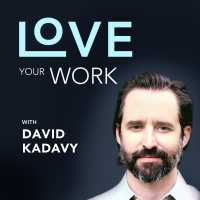


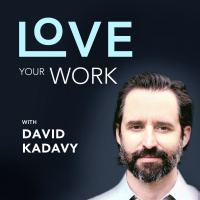


![[Bonus Patreon Preview]: Coffee w/ Kadavy #4](http://media3.ubook.com/catalog/book-cover-image/330901/200x200/9F41A756-ADA5-606D-45BB-E015F012777E.jpg)
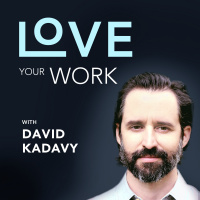
![[NOTE] Submit your questions for the upcoming AMA/Livestream! (kdv.co/ama)](http://media3.ubook.com/catalog/book-cover-image/330901/200x200/EE438C4C-F69B-BB94-D56D-50795027B546.jpg)
